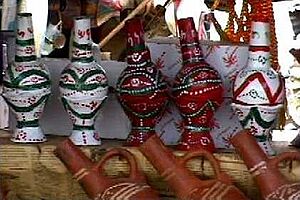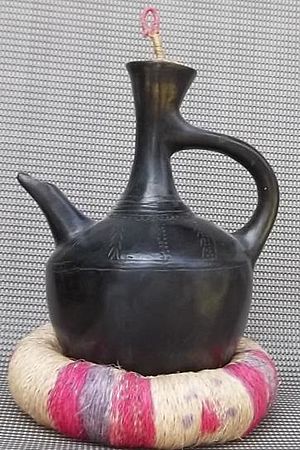Jebena facts for kids
The jebena (Amharic: ጀበና, Arabic: جبنة) is a special Ethiopian and Eritrean coffee pot. It's usually made from pottery (clay). People also use it in Sudan, where the coffee itself is called buna.
Contents
What is a Jebena?

The jebena is most often used in the traditional coffee ceremony. During this ceremony, women serve coffee to their guests in small clay or ceramic cups. They also offer snacks like popcorn, peanuts, and traditional bread called ambasha.
Jebenas are usually made of clay. They have a neck, a spout for pouring, and a handle. Ethiopian jebenas often have a separate spout for pouring out the coffee, while Eritrean ones usually have just one spout at the top for both filling and pouring. Some jebenas have straw lids or different shaped bases.
When the coffee boils in the jebena, it's often poured into another container to cool down, then poured back into the jebena until it bubbles again. To pour the coffee without grounds, a filter (often made from horsehair) is placed in the spout. In Ethiopia, the coffee is served in small pottery cups called sini or finjal.
The jebena is a very important item in Ethiopian homes. Its decorations can even show a family's social status. It's deeply connected to the buna (coffee) and Ethiopia's rich coffee history. There's even a small restaurant in Addis Ababa, Ethiopia, shaped like an Ethiopian jebena!
History of the Jebena
Many people believe coffee was first discovered in Ethiopia by a goat farmer. He noticed his goats became very energetic after eating certain beans. Coffee has been brewed and served with the jebena in Ethiopia since around 1100 A.D. The exact start of the jebena's use in the buna ceremony isn't fully clear, and there are different stories about it.
The buna ceremony and the jebena are very common in the Horn of Africa, especially in Eritrea and Ethiopia. Different areas have their own special ways of doing the ceremony.
The jebena is very important in Ethiopian and Eritrean culture. Families often have just one jebena, and it's usually passed down through generations. It's seen as a valuable family treasure, not just a simple tool. It represents shared culture and importance in society.
How the Jebena is Used
In Ethiopia
Brewing coffee is closely linked to women in Ethiopia and the Horn of Africa. The youngest woman in the family usually starts the coffee brewing process with the jebena. Making coffee in the jebena is also a social event. Families gather and talk while the coffee is being prepared.
Because potters in Ethiopia often don't have tools like pottery wheels, a well-decorated jebena is a special item. A highly decorated jebena can show a family's wealth and status in Ethiopia and Eritrea.
In Ethiopian culture, when coffee is made for the buna in the jebena, it's a time for women to socialize away from men. This has created a strong link between women and coffee making. Women take great pride in their coffee ceremony and in caring for their jebena.
The buna ceremony isn't considered a true buna if a jebena isn't used to prepare the coffee. It's considered impolite for a guest to drink fewer than three cups of coffee from the jebena during a buna. Drinking all three cups is thought to bring good luck.
A household usually takes part in the buna three times a day: morning, noon, and evening. Each time, the woman preparing the buna will announce it to everyone in the house. She invites them to enjoy the ritual before she starts roasting the beans and making coffee in the jebena.
For Ethiopians Living Abroad
Ethiopians who moved to other parts of the world, especially during difficult times in the 1970s and 1980s, still make coffee in the jebena for the buna every day. Even though a jebena might not be expensive, it has great sentimental value. It helps them feel connected to their home country. Ethiopian families in countries like the United Kingdom and the United States continue to make coffee in the jebena. They might use modern tools like stainless steel pans to roast beans or electric grinders, but the jebena remains central to keep their connection to home.
The jebena is also important for women in migrant families. It represents the special routine of the Ethiopian coffee ceremony. Even when families are far from home, the buna ritual feels incomplete without the jebena. The long time it takes to brew coffee in the jebena allows migrant families to connect and strengthens their shared identity with their home country.
As D. Daniel writes in her book, the jebena is "arguably the most important feature of the ceremony." She explains that its shape and design can show the host's ethnic background. While other parts of the coffee ceremony can change, the jebena has always stayed the main part, both in Ethiopia and abroad.
Appearance of the Jebena
The jebena has a long, narrow neck-like spout and a handle for pouring. Its base is usually large and round, with a flat bottom so it can stand steadily. The top is often curved, making it easier to pour in water and coffee grounds. The narrow neck of the spout acts like a strainer, stopping coffee grounds from coming out when you pour. This means the coffee needs less filtering.
The jebena is usually placed on a small decorative cloth stand or on hay. This protects surfaces from its hot base, which has just been over flames. There's also usually a plug at the top, made of cloth, straw, or clay, to stop water from spilling. More modern jebenas might be made of porcelain or metal, looking a bit like Western coffee pots. Jebenas are usually about 20-45 centimeters (8-18 inches) tall. This size is good because people often refill the jebena and brew more coffee several times during one ceremony.
The look of the jebena changes depending on where in Ethiopia or Africa it's from. Most commonly, older women make them from local clay. Some villages are known for making specific types of jebenas, as well as the small cups called sini used in the buna. After being shaped, designs are drawn into the wet clay. Once dry, it's usually painted black or brown. Fancy decorations, like gold or silver plating and detailed painting, are common. These decorated jebenas are often used as symbols of wealth or social status, especially for upper-class families or royalty. Other decorations include bright colors or traditional dot patterns.
There are two main styles: Ethiopian and Eritrean:
- The Ethiopian version has two separate spouts: one for pouring water in and another lower down for pouring the coffee out.
- Eritrean jebenas are made similarly but have only one spout at the top. This spout is used for both filling with water and grounds, and for pouring out the coffee.
The small clay cups used to serve coffee, called sini, are usually made from the same clay and decorated in a similar way to the jebena. They are often placed on a metal tray, which is used to serve the coffee to guests during the buna.
How Coffee is Made in a Jebena
Coffee is brewed in a jebena three times a day: in the morning, at noon, and in the evening. When coffee is being prepared, it's often a time for men and women to talk separately. The oldest woman or the youngest woman of the household traditionally starts the buna and prepares the coffee beans. Women wash, roast, and grind the coffee beans, often mixing them with spices before brewing.
Roasting and grinding the beans can take up to 45 minutes. During this time, popcorn or other small snacks are passed around. After the beans are ready, the coffee is brewed in the jebena and served in three stages. The first stage is called awel, the second kale’i, and the third baraka. The first serving is strong, and each serving after that is slightly weaker. All three stages usually take about two hours.
The water and coffee grounds in the jebena are boiled on a medium-sized fire, usually made with hot coals in a fire pit on the ground. When the coffee is ready, it's poured into small clay or porcelain cups through a sieve to catch any fine coffee grounds. It's served with the snacks that were eaten earlier. Small cups are used so that people can drink three small servings, allowing them to enjoy all three stages of brewing.
While the coffee is being prepared in the jebena, a woman often lights incense. This creates a relaxing atmosphere and adds to the buna ritual. Usually, no sugar, butter, or milk is added to the coffee while it's brewing or after it's served. The coffee is served to people sitting on the ground, with the host bringing a tray of cups to everyone.
Westernized versions of this ceremony follow the same steps but use modern tools. For example, they might roast beans on a stovetop, heat the jebena on a gas stove, and serve coffee in porcelain cups instead of the traditional sini.
See also
 In Spanish: Jebena para niños
In Spanish: Jebena para niños



